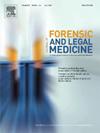内额骨肥厚,骨骼重建鉴定的线索。法国利摩日大学医院尸检人群的流行病学研究
IF 1.2
4区 医学
Q3 MEDICINE, LEGAL
引用次数: 0
摘要
背景:额内肥厚症(hyperostosis Frontalis Interna, HFI)是一种额骨内表的局部增厚,常见于绝经后妇女。虽然经常被忽视,但它可能为法医环境中的重建鉴定提供有价值的信息。方法对法国利摩日大学医院195例尸检个体进行宏观分析,评估HFI患病率及其与年龄、性别和病史的关系。结果在13.8%的病例中发现了HFI,性别差异显著:38.8%的女性表现为HFI,而男性仅为0.78% (p <;0.0001)。hfi阳性个体的平均年龄为66.3岁,而hfi阴性个体的平均年龄为48.4岁,p <;0.00001)。HFI的存在预测女性性别,阳性预测值为96.3%。与抑郁史也有显著的关联。结论HFI虽然敏感性有限,但其特异性高,易检测,是一种有用的重建鉴定辅助标志物。它可能有助于缩小涉及退化或不完整遗骸的生物特征。需要进一步的多中心研究来验证其法医实用性。本文章由计算机程序翻译,如有差异,请以英文原文为准。
Hyperostosis frontalis interna, a clue in the reconstructive identification of skeletons. Epidemiology of an autopsy population at Limoges University Hospital (France)
Background
Hyperostosis Frontalis Interna (HFI) is a localized thickening of the inner table of the frontal bone, frequently observed in postmenopausal women. Although often overlooked, it may provide valuable information for reconstructive identification in forensic contexts.
Methods
We conducted a macroscopic analysis of 195 autopsied individuals at Limoges University Hospital (France) to assess the prevalence of HFI and its associations with age, sex, and medical history.
Results
HFI was identified in 13.8 % of cases, with a striking sex disparity: 38.8 % of females presented with HFI compared to only 0.78 % of males (p < 0.0001). A significant association with older age was observed (mean age 66.3 years in HFI-positive vs. 48.4 years in HFI-negative individuals, p < 0.00001). The presence of HFI predicted female sex with a positive predictive value of 96.3 %. A significant association was also found with a history of depression.
Conclusion
Although HFI has limited sensitivity, its high specificity and ease of detection make it a useful auxiliary marker in reconstructive identification. It may help narrow the biological profile in cases involving degraded or incomplete remains. Further multicenter studies are needed to validate its forensic utility.
求助全文
通过发布文献求助,成功后即可免费获取论文全文。
去求助
来源期刊

Journal of forensic and legal medicine
MEDICINE, LEGAL-
CiteScore
2.70
自引率
6.70%
发文量
106
审稿时长
57 days
期刊介绍:
The Journal of Forensic and Legal Medicine publishes topical articles on aspects of forensic and legal medicine. Specifically the Journal supports research that explores the medical principles of care and forensic assessment of individuals, whether adult or child, in contact with the judicial system. It is a fully peer-review hybrid journal with a broad international perspective.
The Journal accepts submissions of original research, review articles, and pertinent case studies, editorials, and commentaries in relevant areas of Forensic and Legal Medicine, Context of Practice, and Education and Training.
The Journal adheres to strict publication ethical guidelines, and actively supports a culture of inclusive and representative publication.
 求助内容:
求助内容: 应助结果提醒方式:
应助结果提醒方式:


